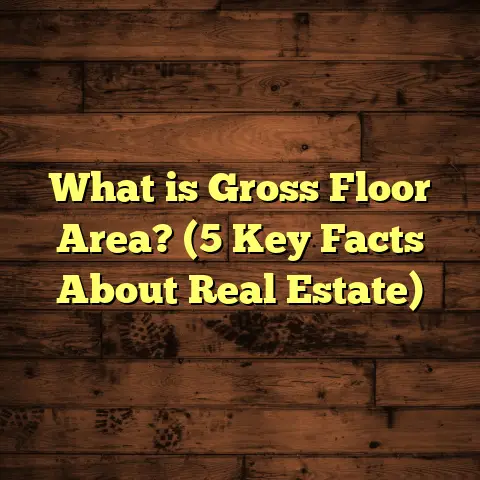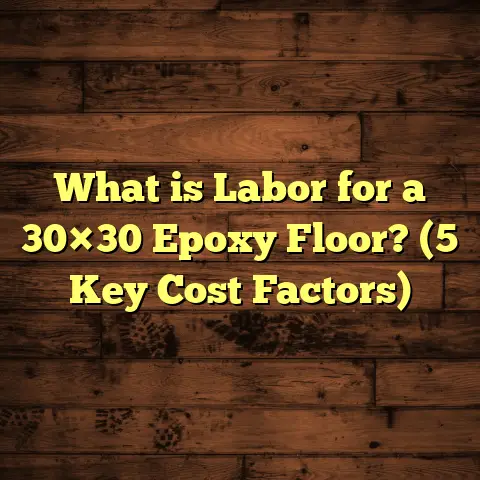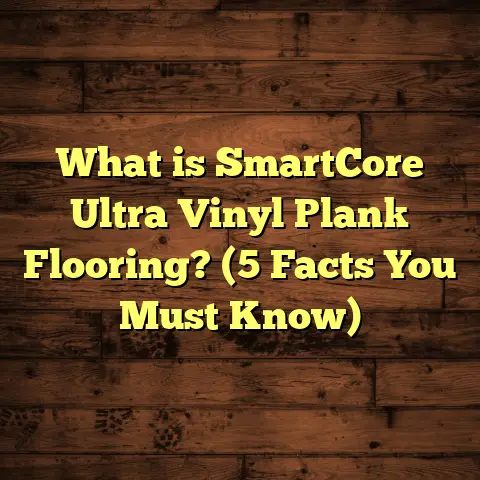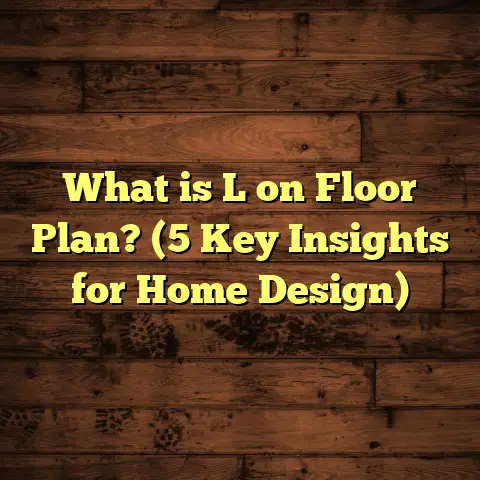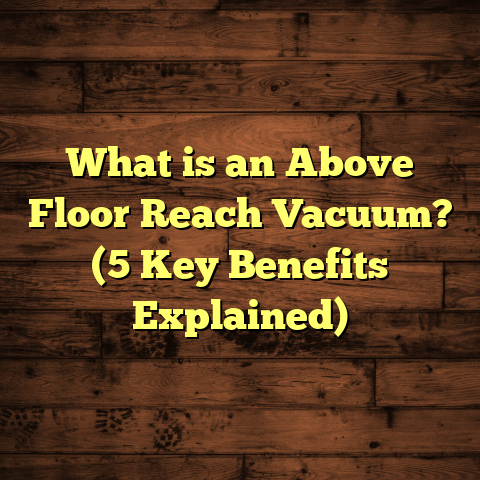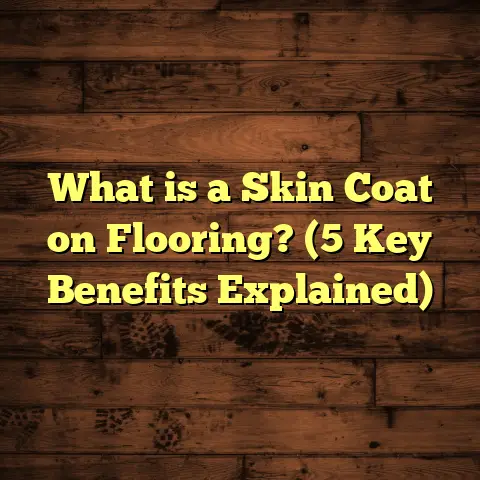What is a 3-Letter Floor Covering? (3 Types You Need to Know)
I remember when I first heard the term “3-letter floor covering,” it piqued my curiosity. I was working on a client’s home, and the supplier casually tossed it out like everyone knew what it meant. Honestly, I didn’t. Over time, after installing hundreds of floors and learning the ropes, I realized these three-letter terms aren’t just jargon—they represent some of the most widely used and versatile flooring options today. They each have their unique strengths and quirks that can make or break your project.
It’s funny how flooring decisions can feel overwhelming, right? When I first started in this business, I often saw homeowners stuck between wanting something that looks great but also lasts through daily wear and tear. They wanted floors that could handle kids, pets, spills, and everything life throws at them without making their wallets cry. That’s where LVT, LVP, and PVC flooring come in—these floorings balance style, durability, and affordability in ways traditional materials sometimes can’t.
Let me share what I’ve learned about these intriguing 3-letter floor coverings—what they really are, how they perform in the real world, their challenges, and how you can decide if one is right for your home or business.
What is a 3-Letter Floor Covering?
To put it simply: these are popular types of vinyl-based flooring products commonly known by three-letter acronyms—LVT, LVP, and PVC.
- LVT stands for Luxury Vinyl Tile.
- LVP means Luxury Vinyl Plank.
- PVC refers to Polyvinyl Chloride, a type of plastic used in many vinyl floor products.
These floorings are designed to mimic natural materials—hardwood, stone, ceramic—while offering practical benefits like water resistance, durability, and often a more affordable price tag.
Why do people choose these over traditional hardwood or tile? Because they offer a compromise that suits many lifestyles. For example, hardwood looks beautiful but can dent or warp with moisture. Tile is water-resistant but cold and hard underfoot. These vinyl options give you the look of these natural materials but with added resilience.
Luxury Vinyl Tile (LVT)
What Makes LVT Special?
LVT comes in tile form and is engineered to look like natural stone, ceramic tile, or wood planks cut into tile shapes. It’s made up of layers: a backing layer for stability, a printed design layer for realistic visuals, a protective wear layer for scratch resistance, and sometimes a topcoat for extra durability.
When I first installed LVT for a client renovating their bathroom and kitchen, I was impressed by how much it resembled actual stone tiles without the cold feel or grout maintenance issues. The family loved that their kids could splash water without worry.
Success Stories with LVT
One standout project was a kitchen renovation for a family with two active kids and a dog. The parents wanted a floor that could take spills from juice boxes, muddy paws, and dropped utensils without looking worn out after just a few months.
We chose a high-quality LVT with a 20-mil wear layer (a thick protective coating). The floor has held up brilliantly for over three years now—no scratches or stains. Cleanup is as simple as sweeping and mopping.
According to the National Floor Covering Association (NFCA), high-end LVT products can last between 15 to 20 years with proper maintenance. That’s impressive given its cost compared to natural stone or ceramic tile.
What About Challenges?
While LVT is generally easy to maintain and durable, it’s not perfect.
- Subfloor Preparation: One of the biggest hurdles is installing LVT over an uneven subfloor. During one project, ignoring this led to bubbling on some tiles within months. Since then, I always stress the importance of subfloor flattening before installation.
- Seam Issues: Cheaper LVT products sometimes have visible seams or edges that separate over time. High-quality brands address this with better locking systems or adhesive backing.
- Environmental Concerns: Some homeowners worry about VOC emissions (volatile organic compounds) from vinyl products. Choosing low-VOC certified LVT can ease these concerns.
My Tips for LVT Installation
- Always inspect and level the subfloor before laying tiles.
- Use recommended adhesives or locking systems per manufacturer guidelines.
- Consider investing in a thicker wear layer (around 20 mils) if you expect heavy foot traffic.
- Avoid dragging heavy furniture directly on the floor to prevent scratches.
Luxury Vinyl Plank (LVP)
What Sets LVP Apart?
LVP mimics hardwood flooring but is made from vinyl planks instead of real wood. It’s designed to look like oak, hickory, maple—often with remarkable realism thanks to high-definition printing and textured surfaces.
I first installed LVP in a basement remodel where moisture was a big concern. The homeowner wanted the warm look of wood but needed waterproof flooring. LVP checked all those boxes perfectly—it resisted moisture while providing that cozy wood feel.
Why Do People Love LVP?
- Waterproof: Unlike hardwood, LVP won’t swell or warp even when exposed to water.
- Softness: It has a bit of give underfoot compared to tile or hardwood.
- Affordability: High-quality LVP usually costs 40-60% less than real hardwood.
- DIY-Friendly: Many LVP products feature click-lock edges that make installation easier for DIYers.
Real-Life Experience
I recall working with a young couple who had just had their first child. They wanted wood floors but were worried about spills and messes. We installed an LVP floor in their living room and kitchen. Two years later, the floors still look brand new despite daily toddler antics.
Some Caveats
- Sunlight Fading: Exposing lower-quality LVP to direct sunlight for long periods can cause fading.
- Indentations: Heavy furniture or appliances can leave dents if the wear layer isn’t thick enough.
- Subfloor Importance: Like LVT, it needs a flat subfloor—otherwise warping or unevenness may occur.
Installation Advice for LVP
- Use underlayment padding beneath planks to reduce noise and add comfort.
- Invest in planks with at least 12 mil wear layers for durability.
- Regularly move furniture pads to avoid permanent indentations.
- Maintain humidity levels in your home to prevent expansion or contraction.
Polyvinyl Chloride (PVC) Flooring
What Exactly is PVC Flooring?
PVC is the plastic material used in many vinyl floors including sheet vinyl and some tiles. It’s known for flexibility, durability, and resistance to chemicals and moisture.
In commercial projects like warehouses or hospitals where floors face heavy machinery or foot traffic every day, PVC flooring performs reliably.
What Makes PVC Stand Out?
- Durability: Highly resistant to abrasion and chemicals.
- Maintenance: Easy cleanup with a mop.
- Versatility: Available as sheets (large rolls) or tiles/planks.
For instance, I helped install PVC sheet flooring in a medical clinic’s exam rooms. The smooth surface and ease of cleaning met tight sanitation requirements perfectly.
Downsides of PVC Flooring
- Comfort: Sheets can be harder and colder underfoot than cushioned vinyl planks.
- Aesthetics: PVC sheets sometimes lack the texture or realism of luxury vinyl products.
- Installation Complexity: Sheet vinyl requires adhesives and professional installation skills; DIY isn’t usually recommended.
Extra Details: Comparing Lifespan & Costs
Here’s more data based on my experience combined with industry standards:
| Flooring Type | Average Cost/Sq Ft | Expected Lifespan | Water Resistance | Ease of Maintenance |
|---|---|---|---|---|
| Hardwood | $8 – $15 | 25 – 100+ years | Low | Moderate (needs refinishing) |
| LVT | $3 – $7 | 15 – 20 years | High | Easy |
| LVP | $2.50 – $6 | 15 – 25 years | High | Easy |
| Ceramic Tile | $5 – $10 | 30+ years | High | Moderate (grout cleaning) |
| Carpet | $3 – $7 | 5 – 10 years | Low | Moderate (stains) |
These numbers help explain why many homeowners now lean towards luxury vinyl options—they strike an excellent balance between price, durability, and look.
Installation Challenges & How I Overcome Them
One thing I’ve learned over countless installations is that even the best flooring material can fail if preparation isn’t right.
For all three types—LVT, LVP, and PVC—the subfloor must be:
- Clean
- Dry
- Level within tight tolerances (usually less than 1/8 inch deviation per 6 feet)
Ignoring this leads to bubbling, cracking, or uneven wear later on.
For example: On one job using LVT on an old concrete slab with tiny cracks and uneven spots, we ground down high areas and filled low spots with leveling compound. This extra prep added time but prevented problems months down the road.
Maintenance & Care Tips from My Experience
Keeping your floor looking good isn’t hard but does need some attention:
For LVT & LVP:
- Sweep regularly to avoid grit scratching the surface.
- Use damp mops—not soaking wet—to clean.
- Avoid harsh chemicals; neutral cleaners work best.
- Place furniture pads under heavy items.
- Use rugs in high traffic zones to minimize wear.
For PVC Sheets:
- Mop with neutral pH cleaners.
- Avoid abrasive scrubbing pads.
- Check seams periodically for lifting and reseal if needed.
More Stories From the Field
I once installed LVP in a small café downtown looking for quick installation and an inviting atmosphere. The owners loved how fast we finished—the click-lock system meant no messy adhesives—and how customers complimented the “wood floor” feel while knowing it could withstand coffee spills.
Another time, I worked with a homeowner who was hesitant about vinyl because of past experiences with cheap products peeling up after a year. We did deep research together on brands with thicker wear layers and warranties over 20 years. She was thrilled when her new LVT floor still looked great after four years despite heavy family use.
Why These Floorings Matter Today
People want floors that keep up with busy lives—not just something pretty but fragile. The pandemic shifted many priorities: more time at home means more wear on floors from family activities. Vinyl options provide peace of mind without sacrificing style.
Plus, technological improvements mean these floors now look incredibly real. Some clients mistake high-end LVP for authentic hardwood until they touch it closely!
Budgeting Your Project: A Closer Look
Using tools like FloorTally has transformed how I plan projects with clients. It helps input local labor costs plus material prices so budgets are accurate upfront.
For example:
| Project Size | Material Cost Estimate (LVT) | Labor Cost Estimate | Total Estimate |
|---|---|---|---|
| 200 sq ft | $600 – $1,400 | $600 – $1,000 | $1,200 – $2,400 |
| 500 sq ft | $1,500 – $3,500 | $1,500 – $2,500 | $3,000 – $6,000 |
| 1000 sq ft | $3,000 – $7,000 | $3,000 – $5,000 | $6,000 – $12,000 |
Knowing these numbers upfront lets you align choices with your budget without surprises later.
Final Words From Me
If you’re considering new flooring options and are curious about these three-letter floorings—LVT, LVP, PVC—remember they’re versatile solutions that fit many lifestyles and spaces. They’re not magic fixes but offer practical durability combined with beautiful designs at attractive prices.
I’ve seen them transform homes by combining style with function in ways traditional floors sometimes struggle with. Whether it’s a busy kitchen needing water resistance or a cozy living room wanting wood looks without high maintenance—the right choice can make your space both beautiful and practical.
Questions about your project? Need help picking the right product or figuring costs? Just drop me a line—I’m happy to share what I’ve learned so you can make flooring decisions confidently.
